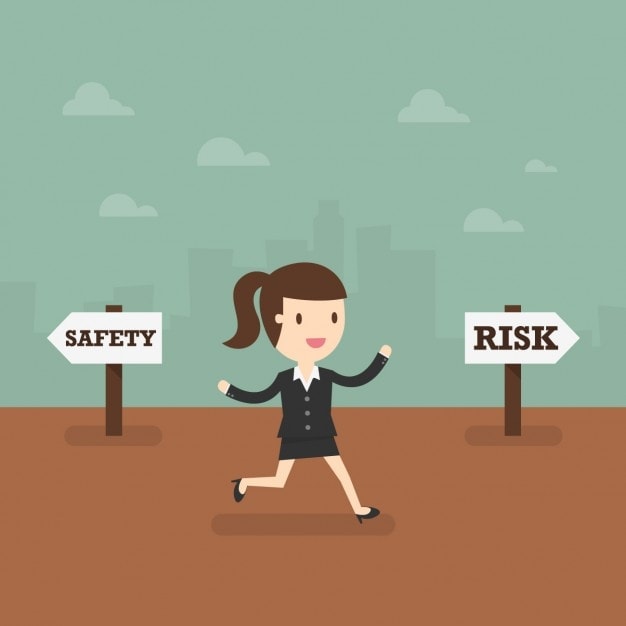In simple terms, business risks can be understood as the risks, threats, uncertainties associated with a business that may hamper in accomplishing the financial goals.
In this post, we will be unraveling the hidden details of business risks and update you about those, so you can make a risk-free business strategy to get the expected profits.
First thing first, let us understand what business risk is.
Table of Contents
What is Business Risk?
When it comes to defining business risk, let me ask you what do you think of it?
You must be thinking of the factors that can cause losses for your business. – And yes, it is true. Let us understand this in more detail-
In the journey of running a business, a company or organization gets exposed to several factors and situations that present a threat to non-achievement of its goal as well as the survival of the company itself.
These situations and factors are called business risks.
Business risk can arise from anywhere and at any time. It’s not always the top authority’s fault in the failure of a business, nor is it always the result of the incompetence of the ground level staff. Similarly, business risk can also come from both internal activities of an organization or external forces.
Any action in life brings along with it some risk. There is no running away from it.
The same is also true in the case of business.
A viable business is bound to come face to face with several risks in its lifetime. The main focus of organizations should be to identify the risk, avoid risks, if possible, develop an efficient plan to counteract the risks and to always have a risk management plan in place.
Understand the importance of knowing your small Business Risks
Many people wish they were their boss. However, very few decide to take the path of establishing a business. Why is that?
It’s mostly due to the risk factor associated with running a business.
Every aspect of business spells risk, but that doesn’t mean that there are no longer surviving and thriving businesses in our world.
The business risk generates from the overall operation of a company. These put business entities in a position where they are not able to give adequate returns to its investors and stakeholders.
One reason for the development of such situations might be the wrong decision making in part of the senior level managers of a company. However, it can also be due to changes in the financial laws of a country.
Some of the factors that can cause risky situations for businesses are:
Factors that may cause Business Risk Situations
- Change in the demand for goods or consumer preferences
- The entry of a strong competitor in the market
- Changes in the making cost of goods
- Changes in Government regulations
- The economic climate of a country
- Changes in the Exchange rate
So, once you are aware of the factors that can be the reasons behind Commerce risk, the next thing you need to understand is the types of commerce risk-
Types of Commerce Risk
There are several types of commerce risks out there. Before you get ready to devise a plan to handle them, you should know the different types of commerce risks because each risk needs to be handled in a specific way.
#1 Physical Risk
Physical risks point to all those risks that present a threat to the business property, material assets, and human resources like fire, theft, water damages, and risk to employees. This type of risk will lead to expenses in the form of cost of repair or replacement.
It may also lead to legal costs in some cases.
#2 Strategic Risk
Every business survives and works towards achieving its goals by devising certain strategiesStrategic risks arise when the strategies or the business model on which a company is functioning is not working anymore. Rather, it is taking the company in the direction of loss and more risk.
Strategies may lose its value as a consequence of various factors. The main thing in such cases is to recognize that the past business model is no longer bearing the desired profits, and there is a need for smarter strategies.
#3 Compliance Risk
Some businesses operate in sectors that are highly regulated with rules and regulations. These industries face a strong compliance risk. The wine industry is one such example; wineries do not have permission to sell to the consumers directly. They first have to sell it to the retailers.
When the rules and regulations put in place by the government or any other recognized organization is not followed, then the company is said to be non-compliant. Non-compliance may be caused due to ignorance or not understanding the laws. These can lead to prosecution, fines, and damage to reputation.
#4 Human Risk
Human risk happens when the staff or their activities become a threat to the company. A company runs successfully due to the relentless hard work of its employees. The same employees also have the potential to take the company in the wrong direction if they are noncompliant or are incompetent.
Further, it’s not just their behavior in the workplace that can impact the business. Misconduct outside office hours and office premises can also present a threat to the company.
An example of this is the involvement of an employee in the misuse or selling of drugs. Also, embezzlement and fraud are other forms of human risks that the company must protect itself from.
#4 Technology Risk
In today’s world, technology plays a great role. The business also is intricately dependent on technology. Therefore, technology failures that lead to an inability to run the business smoothly can be termed as technology risks.
These types of risk come in various forms. One of the basic forms of technology risk is a power outage. This can render valuable hardware and software useless.
Other forms of technological threat are a cyberattack, breach of confidential data, malware infestation in the systems, software failure, and corruption of data.
#5 Financial Risk
One of the most common types of risk is a financial risk. A company may come face to face with financial risk due to internal and external factors. Internal factors can range from non-payment by clients or poor financial planning.
Some external factors that can pose financial risks are a change in government regulations; change in exchange rates and financial market fluctuations.
Financial risks must be taken seriously in all cases. This type of risk has the potential not only to hurt your profits but can also put your company out of business.
In addition to these, there are some other types of risks as well, and you should have a quick look those as well-
Few Additions commerce Risks
- Liquidity Risk
- Exchange Rate Risk
- Systematic Risk
- Reputation Risk
- Country-Specific Risk, etc
After knowing about the types of commerce Risk, you should now learn how to identify them for your business-
Business Identification of Commerce Risk
As mentioned above, there is no way of running away from risk. Taking risk is also what enables companies to gain profits.
However, the thing that can be done to minimize the damage from risk is early identification and taking steps to mitigate those risks. This can be achieved in the following ways:
#1 Identify which sources have the potential to present challenges
The first and foremost thing that a company should do is identifying all the sources that can present risk in the future. Early analyzing of sources will do away with the unwanted risk surprises later. This will also help to monitor activities that may be headed south.
This early preventive step may lead to a huge sigh of relief for the business later.
#2 Take steps now
Once a problem has come to notice, do not wait up for it to turn into something serious. Act as soon as possible. Managers should take immediate steps and should also immediately bring it to the notice of higher authorities.
In this way, the management can sit and brainstorm to devise an effective plan to counteract the situation. Waiting up will only result in more serious problems later that would be even harder to handle.
#3 Bring all levels of employees on board
Recognizing situations that present risks is not just the responsibility of the managers and top-level officials. It is the responsibility of every employee of the company.
To have everyone on board for risk identification and mitigation, you need to train employees at every level. They should be able to identify risks and know how to handle the situation to either minimize or eradicate the risk.
#4 Jot down all industry-specific challenges
Every industry has the probability of facing certain risks. The manager should look into such type of risks beforehand, which are industry-specific. These industry-specific risks can be both internal and external.
One way of doing this is by identifying the problems and crisis faced by other companies operating in the same industry. If other companies operating in the same space as you had or are facing certain risks, then you might face them too in the future.
It will bid you well to jot down these risks beforehand and come up with effective strategies to mitigate or remove such risks when they arise.
#5 Keep a record for challenges
Some risks can happen again and again in the life span of a company. In such a scenario, it is a good idea to keep a record of all the risk the company has faced in the past.
Keeping a record of all the risks will enable a company to find any pattern that is resulting in the development of the risks and also enable them to have an effective plan in place to handle such risks in the future.
Now, in the last section, we will understand how to minimize commerce risk-
How to Minimize Commerce Risk?
#1 Maintain a low debt ratio
A company that is operating in a sector that is of high risk should always maintain a low debt ratio. In this way, it will be able to carry out its financial obligations.
When revenue decreases and debt increases, the company might become bankrupt. On the contrary, in a situation where the company is making huge profits, it will be easily able to fulfill its financial obligations.
#2 Know the ratios to calculate commerce challenges
For calculating the commerce risk, four ratios are calculated by the analysts, and they are-
- Contribution Margin Ratio
- Financial Leverage Effect Ratio
- Operation Leverage Effect Ratio
- Total Leverage Effect Ratio
In addition to these, some statistical methods are also used to calculate risks.
#3 Identify your Commerce Risk & Tackle them Straight Away
You should always make a business strategy that can help you in identifying the possible risks for your business.
You should be aware of external as well as internal risks.
Identifying risks associated with business strategy, compliance laws, and operations in advance will help you minimize or neutralize commerce risks in an effective manner.
Business management strategy should also have the plan to tackle any risk before it grows up.
#4 Have a Risk Management Plan
It is important that you have a proper Risk Management Plan by gauging the possible risks that your business may face. It will be more beneficial if you make it in advance before facing any issue.
Plus, you should also be recording different risks that you had faced and measures that you had taken to neutralize or minimize them.
Wrapping it up!
So, this was all that we thought would help you in understanding the concepts of commerce risk.
For running a successful business, it is inevitable to be aware of all the possible risks, and then, making a plan to minimize, neutralize, and tackle those risks will safeguard you in the future.
Have you ever faced in any commerce risk? What measured would you suggest for neutralizing risks for businesses? Share with us in the comments.
Liked this post? Check out the complete series on Business





